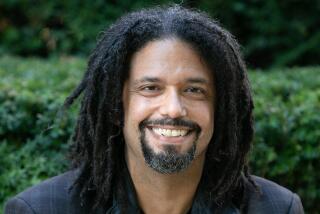Spain ’92 / A Medal Year : America From Abroad : ‘Superficial’ U.S Entry Disappoints at Expo ’92 : Their budget halved by Congress, planners had to scrap the original design and make do.
- Share via
SEVILLE, Spain — The Hollywood stuntman who roars through the U.S. pavilion on a motorized skateboard is perhaps as uniquely American as the Bill of Rights, the U.S. showpiece here at the world’s fair.
But to puzzled foreign visitors, the helmeted stuntman’s significance can be hard to fathom. Just what does a skateboard say about a global superpower? Not a lot, in the view of a sampling of fair-goers one recent afternoon.
“They’ve captured the superficial,” complained Spanish teen-ager Alejandra de Torres.
“The United States could have done a lot more. It’s weak,” said Ramon Romereo, a tour guide from Seville.
Overwhelmed by its neighbors’ array of outdoor theaters, hanging gardens and futuristic buildings, the U.S. pavilion at Expo ’92 is an also-ran--the victim of congressional disinterest in Washington and stiff competition in Seville.
For a fair expected to attract 15 million visitors, Japan built the world’s largest wooden building. Switzerland built a surprising tower made mostly of paper. Chile brought a 66-ton iceberg.
Here on the banks of the Guadalquivir River, Expo has spawned a competitive world in microcosm as 110 nations, 23 international organizations and several corporations vie to make a lasting impression. Pride is certainly a factor in their efforts, but millions of dollars in potential business are also at stake.
Frederick M. Bush (no relation to the President), the pavilion’s commissioner general, concedes that the U.S. pavilion may not be as eye-catching as some of its flashy neighbors. He touts the content, but some have already damned the book for its cover.
“From the outside it looks like a warehouse with a large wall in front to hide its lack of beauty,” said a critic for the conservative Spanish newspaper ABC. “The wall is supposed to be a ‘water screen.’ . . . On the U.S. pavilion, it looks more like the honeycombed rear of an air-conditioning unit that has sprung a leak.”
In early planning, the United States petitioned for the largest site of any foreign exhibitor at Expo. That is what it got. But then along came Congress. It slashed the proposed budget for Expo from $45 million to $22 million--$4 million of which had to be raised from private donors. In fact, U.S. corporations contributed $9 million worth of goods and services, but the original pavilion design had to be scrapped.
Left with the need to fill an empty lot as big as a city block, planners decided to use two 20-year-old geodesic domes already in Europe for trade fairs. A water wall salvaged from the original design and two billboard-sized murals effectively hide the massive domes from passersby outside, but patches of glue dotting the interiors betray their reassembly.
That the United States has devoted fewer resources to Expo than other countries is quickly apparent to foreign visitors at the pavilion. Almost universally, they express disappointment that the United States has not showcased its discoveries in science for an exposition whose theme is “The Age of Discoveries.”
Bush and workers on the pavilion’s staff emphasize that the casual atmosphere and cultural programming are special elements that other pavilions can’t match. Everybody already knows that the United States is a leader in technology, Bush said; the United States has displayed rockets and satellites for years.
“It’s the openness, it’s the participatory nature of our pavilion that makes it unique,” he said. “America is casual and friendly.”
The pavilion’s center court is indeed a popular place to hang out, eat an ice-cream cone and watch the action. On any given day, it might include aerobics instructors exercising in tight Lycra or suntanned athletes kicking a beanbag.
The heart of the U.S. presentation is more substance than splash: one of the 14 original copies of the Bill of Rights, borrowed from Connecticut archives and abroad for the first time.
Accompanying video presentations emphasize the trend toward democracy around the world: the fall of the Berlin Wall, anti-apartheid demonstrators celebrating in South Africa and a lone Chinese youth stopping the tanks in downtown Beijing.
“Wherever you go in the world today, people are looking for the way to govern themselves,” Bush said. “It says that this is something really important.”
But neither the oversized parchment nor the explanatory videos seem to capture the imagination of most visitors: In Europe, many local museums have illuminated manuscripts twice as old. Most people spare only a passing glance for the leathery document.
“It’s the philosophy of the United States. It’s nice. But it’s not exciting,” said Yoshi Murakami, 28, who hails from Osaka, Japan, but works for Ford in Dearborn, Mich.
More to Read
Sign up for Essential California
The most important California stories and recommendations in your inbox every morning.
You may occasionally receive promotional content from the Los Angeles Times.













